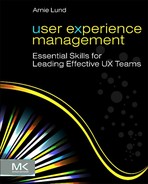Index
A
Accommodation, conflict resolution
210Acquisition
Adaptive path workshop
222Adjacent domains, engaging
13–14Apprenticeship
181–182B
Bell, Alexander Graham
78Bishop, David
214Blanchard, Ken
75Bosenick, Tim
186–189Bouchard, Thomas
9Branding, team
261–262Butler, Keith A.
250Byrne, Robert
175C
Chargeback model
89Churchill, Winston
137CIF
Coaching
fruitful coaching
194–197hints from experienced managers
193praise
197–198rallying the troops
224setting commitments
192–194Cofelt, Anthony
67Commitments, setting
192–194Common Industry Format (CIF)
249Community building, corporate
267Compromise, conflict resolution
210Conflict resolution
208–212Confrontation, conflict resolution
210Conscientiousness
seeDISC profile
Contractor
33–37Cooper, Alan
235Corporate community building
267Critique, meeting
191–192Cross-charge model
89D
DePree, Max
178Design Management Institute (DMI)
223–226Design studio
108–110Detweiler, Mark
237–238De Young, Laura
227DISC profile
184–185Dominance
seeDISC profile
Drucker, Peter
129E
Einstein, Albert
132Elevator pitch, creation
134–137Employee needs
170–172Employee Timekeeping System (ETS)
254Equal opportunity, hiring
31F
Fellenz, Carola
13–15Focusing, team
dimensions of management
153–155elevator pitch creation
134–137integrated information architecture practice building at Sapient
158–159lessons learned
156–158mission statement
132–134soul finding for team
121–127strategic framework
127–128Forming, team development stage
188–189Freelancer
seeContractor
G
Gailway, Timothy
192Gall, John
259Geneen, Harold S.
68Generational differences, workplace
183–184Gould, John
203–204Grief, cycle
175fH
Habitat for Humanity
218Headhunter
seeRecruiter
Hendrick, Hal
221Hints from experienced managers
branding of team
261coaching
193morale
218overview
9professional activity encouragement
204team equipping
118–119vision, strategy, and priority establishment
128work-life balance
214Hiring
Hoffman, Mark S.
153–155Howard, Tharon W.
184–185Human resources
I
Identity, defining for team
165–167Influence
seeDISC profile
Innes, Jon
65–66Innovation, promotion
14–15Intern
32–33International Organization for Standardization (ISO)
249–251Israelski, Edmond W.
98–100L
Layoff
47–50Leadership
see alsoCoaching
attributes
272fmanagement relationship
271–273strategy creation
151–159styles
275–276Lindgaard, Gitte
233Linear Responsibility Chart
seeRACI matrix
Loyalty, creation in team
177–178M
Manning, Harley
70Mentoring
181–182Millatrd, Nicola
233Mission statement
132–134Motivation, strategy creation
150–151N
National Organization for Competency Assurance (NOCA)
39–40Net present value (NPV)
231Norming, team development stage
188–189NPV
O
Office Hours
92Ogilvy, David M.
262Olson, Judy
2–3Organizational transformation
collaboration across organization
254–257overview
227–229return on investment
229–235scaling up by training others
249–251strategy perspective
232–234traditional perspective
230–231value defining to organization
253P
Performance
DISC profiles for new teams
184–185fast-growing team management
186–188generational differences in workplace
183–184hints from experienced managers
165bloyalty creation in team
177–178mentoring and apprenticeship models
181–182team development stages
188–189training organizations
182–183Performing, team development stage
188–189Peters, Tom
208Policy, rationale statements for new policies
185–186Pollard, Dave
80Positioning, user experience team
moving within organization
84–86need for champions
69–72overview
68–86physical collocation of team versus distribution among supported teams
78–80Positioning, user experience
14Posting, jobs
30Praise, coaching
197–198Professional societies
281Project management office (PMO)
152Pulse taking, team
167–170R
Rader, Marcella
275Raiding, employees
30Recruiter
24–25References
29Remote working
Responsibility Assignment Matrix
seeRACI matrix
Resumé
25–26Return on investment (ROI)
manager role
229–235rethinking in organizational transformation
231–232usability ROI
251–252Rohn, Janice
77ROI
Rowling, J.K.
271Rumsfeld, Donald
43S
Säde, Simo
156–158Salary, negotiation
41–43Scholtz, Jean
81SDK
Self-care, importance for managers
219–226Senge, Peter
135Shaw, George Bernard
134Sigchi Panel, highlights
13–15Soken, Nelson
268–269Soul, finding for team
121–127Space
seeEnvironment
Spool, Jared
67Stafford Beer Model
166Steadiness
seeDISC profile
Stengel, Casey
177Storming, team development stage
188–189Sullivan, Kent
274T
Teague, Ross
193Team budget
seeBudget
Team building
consulting team building
55finding great people
30–32hiring
17–43inheriting personnel
43–45interns
32–33job description
layoff
47–50phone screening
27recruiter
24–25references
29resumé
25–26salary negotiation
41–43skill identification
18–24testing of potential hirees
29vendors and contractors
33–37Team creation
development stages
188–189first day experience
59–61funding
Team environment
seeEnvironment
Technology Adoption Model (TAM)
124–125Tools, user experience
111–114Tradition, creation for team
224–225Transformation
Turner, Carl W.
253–257..................Content has been hidden....................
You can't read the all page of ebook, please click here login for view all page.
